Text(e) Image Beat – talks (2015)
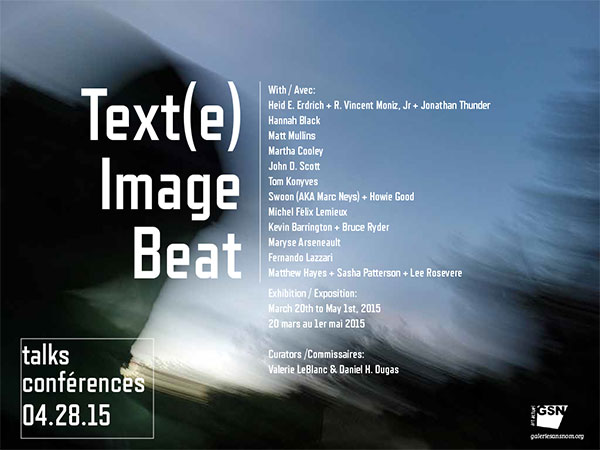
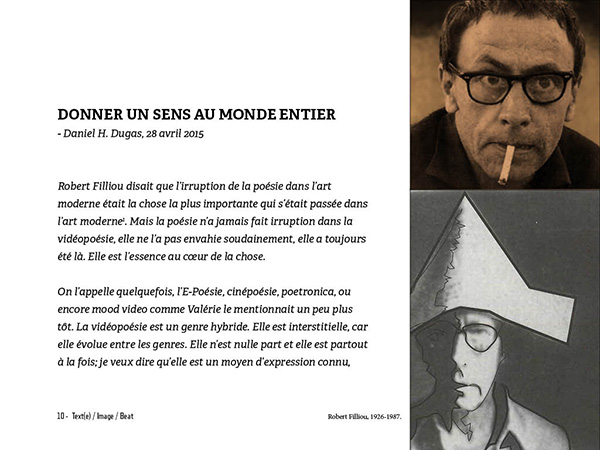
On April 28, Valerie LeBlanc and I each gave a talk at the Galerie Sans Nom during the Frye Festival.
![]() Text(e) Image Beat talks given through the Galerie Sans Nom and the Frye Festival, (pdf 2mb)
Text(e) Image Beat talks given through the Galerie Sans Nom and the Frye Festival, (pdf 2mb)
Text(e) Image Beat opening! (2015)
Le vernissage de Text(e) Image Beat aura lieu le 20 mars 2015 à la Galerie Sans Nom!
The opening of Text(e) Image Beat will be held on March 20 at the Galerie Sans Nom!
With: Heid E. Erdrich, Hannah Black, Matt Mullins, Martha Cooley, John D. Scott, Tom Konyves, Swoon (AKA Marc Neys), Michel Félix Lemieux, Kevin Barrington, Maryse Arseneault, Fernando Lazzari and Matthew Hayes.
La version française sera bientôt disponible
Curators’ Commentary
Valerie LeBlanc and Daniel H. Dugas
Video poetry is a genre that is increasingly drawing the attention of both audiences and creators. We have come a long way since moving pictures with sound required a vast and expensive array of infrastructure and personnel. We are also in a time when the visual vocabulary and knowledge of signifiers is more familiar to wider audiences. This should not come as too great a surprise when we think that what is considered to be the first documented photograph was made close to 200 years ago[1] and that moving picture techniques pioneered in the early 20th century resulted in the first feature film with sound,The Jazz Singer in1927. While photography, moving pictures, and recorded sound / music were first thought to hold value for documentary applications only, the use of these tools are constantly transforming our concepts of art. Through time-based media, ideas move into the thought process; visceral effects are imprinted.
Creators are now presenting their texts visually and / or performing their poems. Many have realized that messages can be effectively conveyed using the multimodal character of video poetry. Similarly to advertisements created for marketing campaigns, these works are characteristically short, less than 5 minutes in duration. Some festivals are asking for works as short as one minute, the duration of some TV ads. The videos in this program have been chosen for their content as well as for the techniques that each creator uses to portray the meaning and aesthetic sense of the content.
The call for Text(e) / Image / Beat did not specify particular themes. Through the necessity of paring down the choices and assembling a flow of works that complemented and gave space to each other, we became aware of recurrent elements. In spite of the fact that the videos originate from many distinct locations, ideas of awaiting / finding miracles and mysteries of living, are frequent. Each work exhibits innovation and imagination, calling upon a wide range of skills to layer meaning. Slam poetry, rants, softly spoken words, hand written notes, and remixes are all used to articulate.
In Pre-Occupied, texts over images; multi-layering stereotypical references from popular culture and memes relating to current and past events carry Heid E. Erdrich’s words like a fast moving river. References to the first American Thanksgiving, Alcatraz, Wounded Knee, Indigenous activists; key words and statements are thrown; fonts are visually woven with voice intonation to deliver meaning. The video opens with an excerpt from Langston Hughes’ The Negro Speaks of Rivers: ‘I’ve known rivers: Ancient, dusky rivers. My soul has grown deep like the rivers.’ Erdrich states the title: Pre-Occupied and then begins her powerful litany, ‘River, River, River, I Never, Never, Never etched your spiral icon in limestone …’. Hughes words continue under Erdrich’s. The dynamics of the lead-in continue through to the end. Closing credits are accompanied with an Anishinaabemowin (Ojibwe) translation of John Lennon’s Imagine. Pre-Occupied hits chords of dreams for political and social equality: held, dashed, revisited and restated.
A series of spirals are drawn over the neck in the opening scenes of Hannah Black’s video of the same name. Through calling attention to the limitations of her childhood drawings, Black brings a discussion of identity. With her own body as the starting point, she steers her words toward ‘… an improbable form of mediation between a self and its constituent parts: family, body, race, gender, …’ Essentially, her video addresses the whole world and its concerns as she draws the personal into the political arena.
In Our Bodies, Matt Mullins remixes a sermon by televangelist Oral Roberts, cutting away excess material, repeating words and phrases, using split screens, and setting inserts to emphasize specific gestures. Mullins closes the videopoem with an excerpt from a sinners’ prayer, ‘… I am ready to perform a miracle in your life … expect delivery.’ As Oral Roberts interprets the Bible, Matt Mullins, in turn interprets Oral Roberts.[2]
Martha Cooley’s Dog Sitting in Eastern Passage uses a combination of devices. While handwritten pages from a notebook bring her thoughts to life, the pages are set within sequences of photos to create movement. Thrown by a heartbroken author, a dog fetches sticks along the Atlantic coastline. Through the work we are reminded of that basic miracle of video and film media, the persistence of vision that brings us the illusion of movement.
John D. Scott breathes life into Elizabeth Bishop’s 1965 poem Sandpiper. He interprets that Bishop anthropomorphizes into the bird. While sandpipers are known to flit persistently on beaches, her life as a revered writer of short stories and poetry was also one of searches, observations, of taking many directions. A haunting whistle, a rattle and clicks of the typewriter open the video and continue to underline the spoken word. Scott’s collaboration includes rotoscoped bird images by Anna Bron and Andrew Whyte, stills and slow moving images of water and beach. Particular passages are emphasized and punctuated through movement and voice.
Having coined ‘videopoetry’ in 1978, Tom Konyves is recognized as one of the pioneers of the genre. In his video ow (n) ed, politically charged meanings are layered and set into a crypted triptych that he describes as a postmodern vision of human slavery. Punctuated by jazz notes, Konyves has positioned quotes from American Slavery As It Is: Testimony of a Thousand Witnesses[3] on the left. In the center, a tower of humans is constructed and collapses.[4] Consumer commentaries play on the right. As the video progresses, messages on the left spill over, slipping to the right. Through erasure (dropping regions of the text and remixing), Konyves is implying new meanings.
Well known for remix, collaborations and atmospheric compositions, Marc Neys (aka SWOON) has supplied the concept, editing, and music in the creation of Five Miles (Simple Brushstrokes on a Naked Canvas). Howie Good has contributed the poem. Excerpts from the 1944 American Military documentary Target for Today, speak about possible bombing but no bodies are seen. Throughout the video an ominous voice repeats ‘five miles.’ Instead of increasing or decreasing the distance to the target, we are forced to hover in abstraction. A slow moving, amorphous bubble suddenly appears. As it floats over green grass the text ‘because a feeling has no form’ is spelled out. In the bellicose tone set by the video, this colorful bubble carries a menacing hint of possible outcomes.
Michel Félix Lemieux’s Brûle le bois vert takes us on a train ride at night. A moving spotlight illuminates the view through a square window. Lemieux describes this work as a poetic and confused reflection on exodus. While we are almost deprived of images in the video, the text is loaded with saturated colors. The words contaminate what we are seeing. In a poem that offers glimpses of mental and emotional moods over any coherent flow of thought, an awareness of solitude pervades.
Kevin Barrington’s I Love the Internet is a skillful fast rant by this Dublin based copywriter and blogger. A collaborative project with Irish animation artist and illustrator Bruce Ryder, the poem advances through use of psychedelic colors and a text matte over quick moving images. The video derives from Barrington’s multi-media e-book of the same name. Barrington states, ‘The impulse was to repel a rising wave of establishment antipathy to social media expression that took hold early in 2013 and threatened to silence satire and online political heckling.’
In constructing Retenir son souffle, Maryse Arsenault used French and English to deliver her texts; a speaking and singing voice; images and sound shot in her own environment; and found footage of a weather phenomenon. The voice, which we understand as Maryse, asks for help. It is the voice that we sometimes need to hear when we are hoping for a miracle. The video ends with sounds of whistling and a bell like that of a life buoy. A small bird goes out and returns 3 times; the repetition works like an incantation in the closing of this lullaby.
Montserrat follows Retenir son souffle in the program. These two very different videopoems explore threads of holding up the world through dark times. To relate an excerpt of Jorge Luis Borges’ Amanecer (Break of Day), Fernando Lazzari uses ‘font as character’. Borges’ poem speaks of a world held together by the imagination of those who inhabit the night, until the day returns and others awake to define its shape with their presence. At times, images move rapidly; sometimes they hover to become imprinted as font generation builds monuments to the words.
Slam Poet Sasha Patterson performs her poem Tonight is for the Trees; cinematography and editing is by Matthew Hayes, with music by Lee Rosevere. Patterson walks out of the darkness along a tree-lined road. At first lit by only a flashlight, she is suddenly in full light and continues to address her audience as she walks toward the camera. The effect is simple and effective. Tonight is for the Trees brings reminders of Christopher Dewdney’s August as both poems celebrate summer and life in southern Ontario.[5] Each passage of Dewdney’s list: nature’s creatures and the beauty of geological formations begins with ‘because’. Patterson repeats ‘ tonight is for …’ before each new item in her long list of dedications. Links between the two works are not literal but meet in sentiment, intention and appreciation for life, nature and the human presence in it all. Patterson’s fresh and confident voice epitomizes hope.
While Pre-Occupied dropped us into the middle of all things worldly and imagined, Tonight is for the Trees brings closing notes to Image / Text(e) / Beat. In the long history of the known and unknown, the visible and the invisible, the spoken and the unspoken, video poetry sets the prompts, the magic of visions hinted by the words, images and sounds. Rhythm set by videopoetry widens the chances of getting messages out. We hope that a tradition of video poetry will come to be established in Moncton. With the number of poets per capita, it seems to be a viable, and maybe inevitable prospect.
[1] The First Photograph, Harry Ransom Center, University of Texas at Austin:http://www.hrc.utexas.edu/exhibitions/permanent/firstphotograph/
Nicéphore Niépce, Wikipedia: http://en.wikipedia.org/wiki/Nicéphore_Niépce
[2] To appreciate the effectiveness of Mullins’ remix, check out The Hand of God, from Oral Roberts Crusade, St. Petersburg, FL (1964) on You Tube:https://www.youtube.com/watch?v=rGi_vRS9zH8
[3] Theodore Dwight Weld, 1803-1895, ‘American Slavery As It Is: Testimony of a Thousand Witnesses’: http://docsouth.unc.edu/neh/weld/summary.html
[4] In 2010, castells of Catalonia were declared by UNESCO to be amongst the Masterpieces of the Oral and Intangible Heritage of Humanity: http://www.unesco.org/culture/ich/index.php?lg=en&pg=00011&RL=00364
[5] Christopher Dewdney, August, Poetry In Motion (1982), YouTube:https://www.youtube.com/watch?v=CN3AaYp_kyY
International Film Poetry Festival (2014)
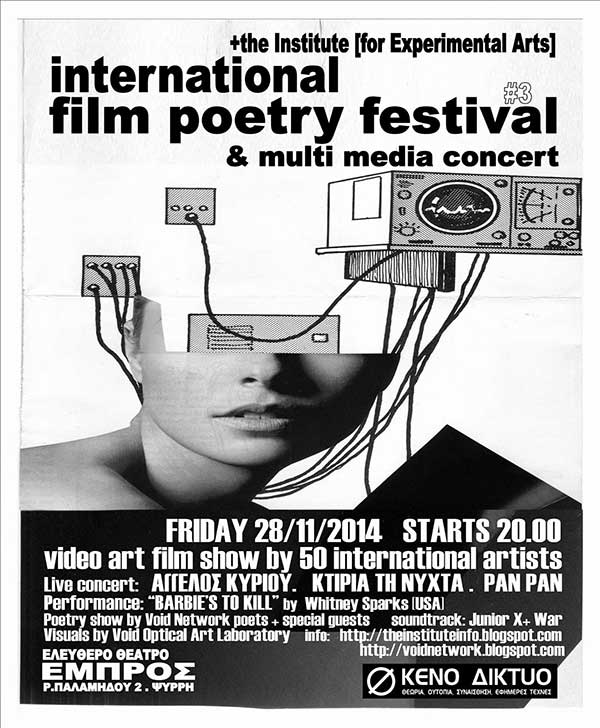
International Film
Poetry Festival 2014
friday 28/11/2014 / starts 20.00
Video artists:
D.H Dugas CAN | M. Dickes USA | D. Wotton FR
M. Piatek POL | J. Solomko UKR | I. Shevchenko UKR
S. Wiegner GER. |
J. Brok & A.Marseille HOL
T. Bentley UK | Visto Desde el Zaguán IRE
K. Polischuk UKR | MAI ΙT | Κ. Καρβέλη GR
A. Anderfuren HUNG | Γ.Πατεράκης GR | S. San GER
V. LeBlanc CAN | E.Tsymbalyuk UKR | E.Στάμου GR
M. Craven AUSTR | P. Gialis GR | L. Kalyadin RUS
N.Κωστόπουλος GR | M. Mullins USA
T. Granot ISR | Orquesta de Poetas SP
E. Al-Ansari UK | D. Dirgela LTH |V. Giourousis USA
P. Müller GER | M. Lland UK | Bobye FR
K. Sargent UK | D. Fiori & O. Pohankova AUS
I. Andreevski HOL | Θ. Σπυριδάκη GR | G. Pryor USA
Didi SUD | E. Vinogradova UKR | Θ. Πάνου GR
Aγγ. Φραντζής, Ν. Πάστρας GR | S. Brova, P. Lypa RUM
J. D. Scott USA | I. Oravin FNL | S. Samyi GER
programme: http://issuu.com/
Performance:
Whitney Sparks (USA) | Iωάννα Λιούτσια
Live Concerts:
AΓΓΕΛΟΣ ΚΥΡΙΟΥ
PAN PAN
KTIΡΙΑ ΤΗ ΝΥΧΤΑ
Μulti Media Poetry Show:
T. Σαγρής | Σ. Δουτσίου | Γ. Ραουζαίος |
Ο. Μπατάκης | Κ. Ζησάκη
Fr. Avenbach | Στ. Καλογήρου |
I. Γαϊτανάρου | MattaBee
Πηνελόπη Δ. + TripmakerYoung |
Δ. Αναλυτής | Xρ. Συριοπούλου
Soundtrack:
Junior X . War
Visual Art:
Void Optical Art Laboratory
Produced by
Void Network-Κενο Δίκτυο
http://voidnetwork.blogspot.
+the Institute [for Experimental Arts]
http://theinstituteinfo.
Occupied theatre
EMBROS
R.Palimidou 2 Psiri.
athens. greece
FREE ADMISSION / EIΣΟΔΟΣ ΕΛΕΥΘΕΡΗ
The yearly International Film Poetry Festival will be held for third time in Greece on Friday 28/11/2014 2014 in Athens. Approximately 1000 people attended the festival last year.
There will be two different zones of the festival. The first zone will include video poems, visual poems, short film poems and cinematic poetry by artists from all over the world (America, Asia, Europe, Africa). The second zone will include cross-platform collaborations of sound producers and music groups with poets and visual artists in live improvisations.
The International Film Poetry Festival 2014 attempts to create an open public space for the creative expression of all tendencies and streams of contemporary visual poetry.
It is very important to notice that this festival is a part of the counter-culture activities of Void Network and + the Institute [for Experimental Arts] and will be non-sponsored, free entrance, non commercial and non profit event. The festival will cover the costs (2000 posters, 15.000 flyers, high quality technical equipment e.t.c.) from the incomes of the bar of the festival.
All the participating artists and the organizing groups will participate voluntary to the festival.
Void Network started organizing multi media poetry nights in 1990. Void Network and +the Institute [for Experimental Arts] believe that multi media Poetry Nights and Video Poetry shows can vibrate in the heart of Metropolis, bring new audiences in contact with contemporary poetry and open new creative dimensions for this ancient art. To achieve this, we respect the aspirations and the objectives of the artists, create high quality self organized exhibition areas and show rooms, we work with professional technicians and we offer meeting points and fields of expression for artists and people that tend to stand antagonistically to the mainstream culture.
Vidéopoésie GSN (2014)
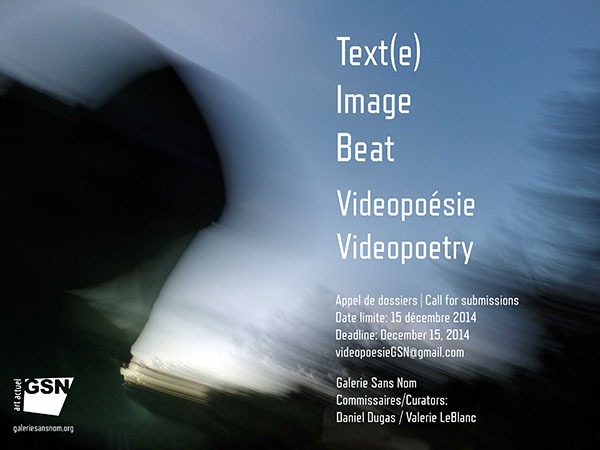
Text(e) Image Beat
La Galerie Sans Nom organise avec les commissaires Daniel Dugas et Valerie LeBlanc une exposition de vidéos poésie qui sera présentée du 20 mars au 1 mai 2015.
Les œuvres recherchées sont des poèmes sur écran où le texte, l’image et le son s’entremêlent. La durée des vidéos ne doit pas excéder 5 minutes. Les œuvres doivent avoir été réalisées après janvier 2013. Sans sous-titres si la langue originale du film est le français ou l’anglais. Avec des sous-titres en français ou en anglais pour les autres langues. Une courte biographie et un synopsis doivent accompagner chaque soumission. Les vidéos sont acceptées en ligne via DropBox ou Vimeo.
L’inscription est gratuite. Les artistes sélectionnés recevront des droits d’exposition suivant les normes du CARFAC.
Appel de dossier
Date limite: 15 décembre 2014
The Galerie Sans Nom is organizing a screening of videopoetry with the curators Daniel Dugas and Valerie LeBlanc. The exhibition will be presented from March 20 – May 1, 2015.
The work should be screen-based poems where the text, image and sound intermingle. The maximum duration of the work cannot exceed 5 minutes and must have been realized after January 2013. The works must be in either French or English. If the language in the video poem is other than French or English, the artist is required to submit a version that is subtitled in French or English.
All video poems must be received by the December 15 deadline through a file hosting service (Dropbox )or through Vimeo. A short artist bio and synopsis of the video poem must accompany each submission. No entry fee, CARFAC rates will be paid.
Call for submission
Deadline: December 15th, 2014
Glissement (2012)
Glissement (2012) from Daniel H. Dugas on Vimeo.
My uncle Camille was a gifted organist, photographer and a very private man. When he died, his photographs and slides were distributed to family members, but there was little context for the material. I received images of Madrid, Rome and Paris. While most of them had a touristic quality, others were more personal. I noticed that some of the colors were starting to fade away. His past, that no one could explain, was slowly disappearing. Soon there would be nothing left.
I started to superimpose the images. Doubling them up gave hope that memories embedded there would gather new strength.
Camille Melanson (1917-2003) – My uncle, a priest, was granted permission to pursue doctoral studies in Paris by his church, in the early 1960’s. After 4 years, when it was time to finalize his thesis, his congregation decided that they could no longer pay his way. Faced with a demand to return to his small parish in Canada, Camille decided to leave the priesthood and moved to Montréal to rebuild his life. After a few years he bought a small house. He had the chance to purchase the massive organ from the Parc Jarry and installed it in his basement. This organ had been played during the Montréal Expos home games and it became one of the many keyboards that he owned. At the time of his death, the organ was sold with the house, as it was impossible to remove.
2014 La Galerie d’art Louise et Reuben-Cohen, Université de Moncton, NB
2013 International Film Poetry Festival, EMPROS Theatre, Athens, GR
2013 Co-Kisser Festival, Minneapolis College of Art and Design, Minneapolis St-Paul, MN
2013 Filmpoem Festival, Dunbar, SCT
Évanescence (2012)
Évanescence (2012) from Daniel H. Dugas on Vimeo.
Evanescencia (2012) version espagnol from Daniel H. Dugas on Vimeo.
Quelle est cette épouvante, cette épouvantable époque d’évanescence dans laquelle nous vivons ? Tout s’efface rapidement, brusquement. Ce qui s’était posé devant le regard avec tant d’effervescence s’est enfui presque instantanément, a disparu en nous touchant.
2014 La Galerie d’art Louise et Reuben-Cohen, Université de Moncton, NB
2012 IV Festival Internacional de Videopoesía “por la Tierra”, Buenos Aires, AR
Insomnia (2012)
insomnia – Italian subtitles (2012) from Daniel H. Dugas on Vimeo.
Insomnie – English subtitles (2012) from Daniel H. Dugas on Vimeo.
A television show on the Big Bang theory adds to the anguish of not being able to sleep. What would happen to dreaming if time itself disappeared?
Une émission de télévision sur la théorie du Big Bang vient ajouter à l’angoisse de ne pas pouvoir dormir. Qu’arriverait-il au sommeil si le temps lui-même disparaissait ?
Traduzione di Antonella D’Agostino
2014 La Galerie d’art Louise et Reuben-Cohen, Université de Moncton, NB
2013 6ième edition La Parola immaginata, Treviglio, IT
2013 Ok.Quoi?! Contemporary Arts Festival, Struts Gallery, Sackville, NB
2013 PoetryFilm Equinox, PoetryFilm, Charlotte Street Hotel Cinema, London, UK
Standard of Truth- Liberates Words (2014)
Standard de vérité / Standard of Truth.
Dugas H Daniel STANDARD OF TRUTH from liberated words poetry films on Vimeo.
Liberated Words Festival (2014)
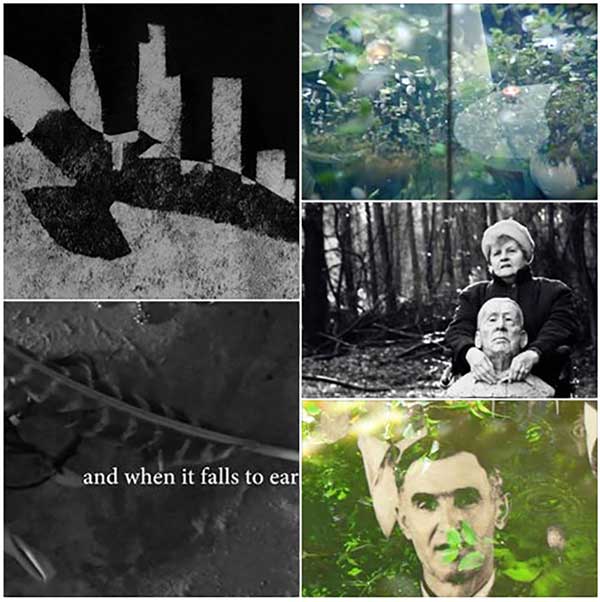
I am happy be in such good company as was shown at this year’s Liberated Words Festival!
————————————————————————————–
CONGRATULATIONS! To everyone who took part in Liberated Words festival and our competition finalists. The winners were:
Best Music/Sound – judges Rich Ferguson and Mark Wilkinson
1st Proem: to Brooklyn Bridge by Suzie Hanna and Tom Simmons
2nd In droplets by Lorenzo Scacchia
3rd If grief were briefly to disappear by Marc Neys, Stevie Ronnie and Nic Sebastian
‘We made our assessment based on the effectiveness and aesthetic quality of the piece as a whole. Some factors we considered were:
Was the spoken word moving intellectually or emotionally?
Did the visuals enhance or elucidate the meaning of poem?
Did the images evolve over time, thereby increasing the ideas communicated?
Were the images thoughtfully produced and carefully considered?
Did the sound design enhance or distract from the spoken word?
Regarding the winning piece: We found the visual treatment in Proem to be arresting and original; clear in its intentions and unified in its design as it evolved visually throughout the piece. A balanced and elegant pairing of spoken words and moving pictures.’
————————————————————————————–
Best Editing: Judges poet Helen Moore and filmmaker Howard Vause
1st On A Prophet, Kathleen Roberts and Dave Richardson
2nd Proem: to Brooklyn Bridge, Suzie Hanna and Tom Simmons
3rd Standard of Truth, Daniel H. Dugas
‘Helen and I agreed that the editing of On a Prophet had both simplicity and emotional complexity, was truly compelling and that all it’s elements formed a stunningly integrated whole. Proem is an animation tour de force – in a class of it’s own really – and we both loved Standard of Truth for it’s quirkiness and narrative restraint.’
http://liberatedwords.com
https://www.facebook.com/pages/Liberated-Words/157035061146693
Videopoetry (2014)
For me, the poetic experience has always been a visual experience. Although videopoetry is often a collaborative process between a poet and a filmmaker, it is for me, most of the time, one continuous action. When I started to write poetry I also started to experiment with super 8 and creating live soundtracks for the reels. The blend of text, image and music seemed a natural transaction between mediums. But it is not only a back and forth movement between words, images and sounds, the action quickly becomes a passage to discover something new, to unearth a unique presence. We know now that the lines between mediums are fragile, that the walls are now porous and we are thankful for this evolution. We can travel from one genre into another to try to make sense of the whole world. Video poetry sits at the juncture of oral tradition, typography and vibrations: a fork in the road. It sometimes tells a story through words (narrative-poetry) and at other times, through moving images (non-linear abstraction). In spite of the fact that videopoetry always shows with a red wavy underlines in Microsoft Word, it is not an error. It is a form a comprehension. It is a good road to travel.
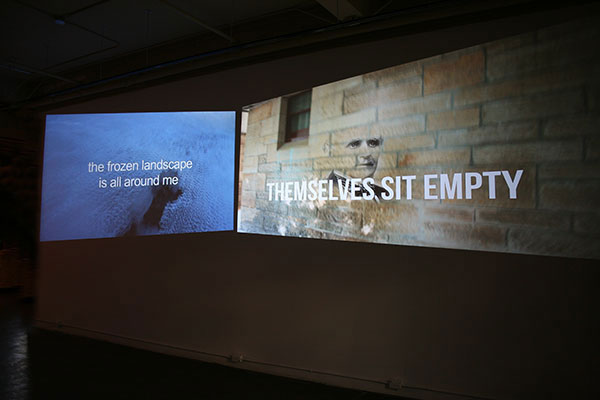
Still from What We Take With Us at The New Gallery (2012) Video installation with Valerie LeBlanc
Daniel H. Dugas
Archives
Blogroll
- A.I.R. Vallauris
- ACAD
- Adobe additional services
- Adobe Creative Cloud
- AIRIE
- Amaas
- Amazon Author Central
- ARTothèque
- Australian Poetry
- Basic Bruegel
- Bitly
- CCCA
- CDBaby
- Cycling 74
- Dissolution
- Éditions Prise de parole
- Emmedia
- eyelevelgallery
- FAVA
- Festival acadien de poésie
- Festival FRYE Festival
- FILE – Electronic Language International Festival
- Freeware list
- Fringe Online
- Galerie Sans Nom
- Gotta Minute Film Festival
- Instants Vidéo
- JUiCYHEADS
- Kindle Direct Publishing
- Klondike Institute of Art and Culture
- La Maison de la poésie de Montréal
- La Maison de la Poésie et de la Langue française Wallonie-Bruxelles
- Laboratorio Arte-Alameda
- Le Centre Jacques Cartier
- Liberated Words
- Maison Internationale de la Poésie – Arthur Haulot
- MediaPackBoard
- Miami Book Fair International
- Monoskop
- Mot Dit
- NSCAD University
- Paved Arts
- PoetryFilm
- Portail des auteurs du Nouveau-Brunswick
- RECF
- Revue Ancrages
- Salon du Livre du Grand Sudbury
- Sculpture Space
- Subtropics.org
- Sydney college for the arts
- The Centre for Contemporary Canadian Art
- The New Gallery
- Trevigliopoesia
- tumbler-documents
- V Tape
- Valerie LeBlanc
- VideoBardo
- Void Network-Κενο Δίκτυο
Categories
- #covidpoèmes
- Advertisement
- AIRIE
- Ancrages
- anthology
- Anthropocene
- Architecture
- Around Osprey
- art
- Article de presse
- arts visuels
- audio
- Australian Poetry
- Basic Bruegel Editions
- Book
- book fair
- Cafe Poet Program
- Ce qu'on emporte avec nous
- Citations gratuites
- Collaboration
- commentaire
- commentary
- Compte rendu
- conférence
- Conservation Foundation of the Gulf Coast
- COVID-19
- Critique littéraire
- culture
- Daniel Dugas
- Design
- Édition Michel-Henri
- Éditions Perce-Neige
- Éloizes
- Emmedia
- emoji etc | émoji etc
- Environnement
- essai
- essay
- Everglades
- Exhibition
- festival
- Festival acadien de poésie
- Festival Frye Festival
- FIPTR
- Flow: Big Waters
- Fundy
- Habitat
- installation
- Instants Vidéo
- interactivity
- journal
- JUiCYHEADS
- Kisii
- L'Esprit du temps
- laptop
- Leaving São Paulo
- lecture
- Livre
- logos
- Magazine
- Miami Book Fair
- Moncton 24
- novel
- OASIS
- oil spill
- perception
- performance
- Photo
- poésie
- Poetic Licence Week
- Poetry
- politics
- politique
- press
- Prise de parole
- Revue Ancrages
- salon du livre
- sculpture
- Sculpture Space
- sound
- Souvenirs
- Spirit of the Time
- Style & Artifacts
- Symposium d'art/nature
- talk
- television
- The New Gallery
- Uncategorized
- Valerie LeBlanc
- vidéo
- vidéopoésie
- Videopoetr/Vidéopoésie
- videopoetry
- visual arts
- What We Take With Us
- youth literature








